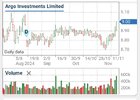Dona Ferentes
A little bit OC⚡DC
- Joined
- 11 January 2016
- Posts
- 15,107
- Reactions
- 20,487
FY24
Record fully franked dividend maintained
Argo’s final dividend to shareholders has been maintained at a record high of 18.0 cents per share, fully franked.
In addition to the benefit of franking credits, the final dividend includes a LIC capital gain component of 3.0 cents per share.
Investment portfolio
During the financial year, Argo purchased $344 million of investments, which included new holdings and additions to existing positions. Over the same period, Argo received $287 million from sales of investments, including numerous takeovers.
The larger movements in the portfolio during the period were:
Purchases
APA Group
BHP Group
CSL
IDP Education
Resmed*
Santos
Woodside Energy Group
Woolworths Group
* New portfolio position
Sales
ADBRI (takeover)**
Australian United Investment Co.
Estia Health (takeover)**
Invocare (takeover)**
Liontown Resources**
National Australia Bank
Wesfarmers
** Fully exited position
The total number of stocks in the investment portfolio decreased from 89 to 86, reflecting considerable merger and acquisition activity in the Australian share market over the period.
Record fully franked dividend maintained
Argo’s final dividend to shareholders has been maintained at a record high of 18.0 cents per share, fully franked.
In addition to the benefit of franking credits, the final dividend includes a LIC capital gain component of 3.0 cents per share.
Investment portfolio
During the financial year, Argo purchased $344 million of investments, which included new holdings and additions to existing positions. Over the same period, Argo received $287 million from sales of investments, including numerous takeovers.
The larger movements in the portfolio during the period were:
Purchases
APA Group
BHP Group
CSL
IDP Education
Resmed*
Santos
Woodside Energy Group
Woolworths Group
* New portfolio position
Sales
ADBRI (takeover)**
Australian United Investment Co.
Estia Health (takeover)**
Invocare (takeover)**
Liontown Resources**
National Australia Bank
Wesfarmers
** Fully exited position
The total number of stocks in the investment portfolio decreased from 89 to 86, reflecting considerable merger and acquisition activity in the Australian share market over the period.


